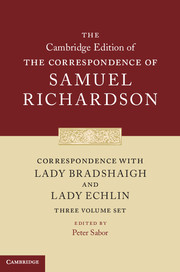Book contents
- Frontmatter
- Contents
- General Editors’ Preface
- Acknowledgements
- Chronology
- List of Abbreviations
- General Introduction
- Volume I Richardson’s Correspondence with Lady Bradshaigh and Lady Echlin, 1748–1753
- Volume I Richardson’s Correspondence with Lady Bradshaigh and Lady Echlin, 1748–1753
- Volume II Richardson’s Correspondence with Lady Bradshaigh and Lady Echlin, 1754–1757
- Volume II Richardson’s Correspondence with Lady Bradshaigh and Lady Echlin, 1754–1757
- Volume III Richardson’s Correspondence with Lady Bradshaigh and Lady Echlin, 1758–1762
- Volume III Richardson’s Correspondence with Lady Bradshaigh and Lady Echlin, 1758–1762
- Appendix I Lady Bradshaigh’s and Samuel Richardson’s Commentary on Clarissa
- Appendix II Lady Bradshaigh’s and Samuel Richardson’s Commentary on Sir Charles Grandison, Volume VII
- Appendix III Lady Echlin’s Alternative Ending for Clarissa
- Index
Appendix I - Lady Bradshaigh’s and Samuel Richardson’s Commentary on Clarissa
Published online by Cambridge University Press: 16 July 2022
- Frontmatter
- Contents
- General Editors’ Preface
- Acknowledgements
- Chronology
- List of Abbreviations
- General Introduction
- Volume I Richardson’s Correspondence with Lady Bradshaigh and Lady Echlin, 1748–1753
- Volume I Richardson’s Correspondence with Lady Bradshaigh and Lady Echlin, 1748–1753
- Volume II Richardson’s Correspondence with Lady Bradshaigh and Lady Echlin, 1754–1757
- Volume II Richardson’s Correspondence with Lady Bradshaigh and Lady Echlin, 1754–1757
- Volume III Richardson’s Correspondence with Lady Bradshaigh and Lady Echlin, 1758–1762
- Volume III Richardson’s Correspondence with Lady Bradshaigh and Lady Echlin, 1758–1762
- Appendix I Lady Bradshaigh’s and Samuel Richardson’s Commentary on Clarissa
- Appendix II Lady Bradshaigh’s and Samuel Richardson’s Commentary on Sir Charles Grandison, Volume VII
- Appendix III Lady Echlin’s Alternative Ending for Clarissa
- Index
Summary
On 15 December 1748, Samuel Richardson sent a letter to Lady Bradshaigh, whose identity was still unknown to him and who was still using the pseudonym ‘Belfour’. In his letter, Richardson told his correspondent that he had sent her a presentation copy of all seven volumes of Clarissa: ‘the whole Work courting your Acceptance and Perusal’ (vol. I , 68). This is the copy that she would annotate, probably in 1749 or 1750, before receiving a presentation copy of the much revised third edition from SR on 17 March 1751. She is unlikely to have annotated the first edition after or even shortly before receiving the revised edition.
On the fly-leaf of each of the volumes, Richardson wrote the inscription ‘From The Author’. On receiving the set, Lady Bradshaigh wrote her name, ‘Do: Bradshaigh’, directly over each inscription in each volume (adding the date, ‘1748’, beside her name in volume I). She probably did so to conceal the origins of her copy from curious visitors to Haigh Hall, although more elaborate explanations for the unusual placement of her signature have been offered. PatriciaH.Marks believes that in this over-writing ‘the relationship between author and reader could hardly bemore emblematically declared’, while JaniceBroder finds it ‘symbolic of the claim to textual power made by Lady Bradshaigh's annotations throughout her volumes’. Janine Barchas suggests that Lady Bradshaigh's ‘gestures on the book's fly-leaves are representative of the manner in which she confidently attempts to impose her readings of the book over that of its author in her many annotations and “corrections”’.
Lady Bradshaigh annotated her copy copiously, writing nearly four hundred comments in all. She treated volumes I and II, set at Harlowe Place, relatively lightly, but once Clarissa leaves the family estate, had a great deal to say on each of the remaining volumes, with volume VII receiving the most extensive remarks of all. Part of her commentary takes the form of stylistic corrections and suggested improvements. There are also, however, more extensive responses, at times admiring and at times indignant, when she reads a passage to which she objects. Before she undertook this task, she had already read at least the first five volumes of the novel: volumes I–IV well before she began her correspondence with Richardson (in July 1748) and V in November 1748.
- Type
- Chapter
- Information
- Correspondence with Lady Bradshaigh and Lady Echlin , pp. 792 - 918Publisher: Cambridge University PressPrint publication year: 2016

